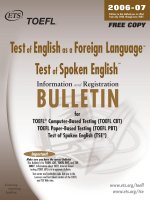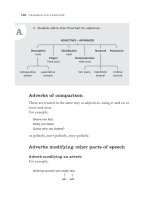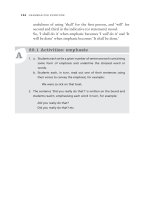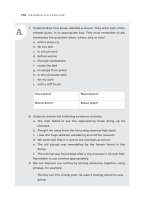Tài liệu Grammar for everyone part 1 doc
Bạn đang xem bản rút gọn của tài liệu. Xem và tải ngay bản đầy đủ của tài liệu tại đây (184.62 KB, 7 trang )
Barbara
Dykes
Practical tools for learning and teaching grammar
ACER Press
Grammar
for
Everyone
Practical tools for learning and teaching grammar
Barbara
Dykes
First published 2007
by ACER Press, an imprint of
Australian Council for Educational Research Ltd
19 Prospect Hill Road, Camberwell, Victoria, 3124
www.acerpress.com.au
Text © Barbara Dykes 2007
Design and typography © 2007 ACER Press
This book is copyright. All rights reserved. Except under the
conditions described in the Copyright Act 1968 of Australia
and subsequent amendments, and any exceptions permitted
under the current statutory licence scheme administered by
Copyright Agency Limited (www.copyright.com.au), no part
of this publication may be reproduced, stored in a retrieval
system, transmitted or broadcast in any form or by any means,
optical, digital, electronic, mechanical, photocopying, recording
or otherwise, without the written permission of the publisher.
Edited by Ruth Siems
Cover design by mightyworld
Text design by Mason Design
Typeset by Mason Design
Cover illustration by mightyworld
Illustrations by Fiona Katauskas
Printed in Australia by BPA Print Group
National Library of Australia Cataloguing-in-Publication data:
Dykes, Barbara, 1933- .
Grammar for everyone: practical tools for learning and
teaching grammar.
Bibliography.
Includes index.
ISBN 9780864314789 (pbk.).
1. English language - Grammar - Study and teaching
(Tertiary). 2. English language - Grammar - Problems,
exercises, etc. I. Title.
428.207
iii
Foreword
After four years as Minister for Education, Science and Training,
I now have the responsibility of focusing on Defence. These days
my office walls are covered with photos of service men and women
and souvenirs from visits to battlefields and bases.
But the largest portrait in my Canberra office is still of someone
I have the highest admiration for and who continues to remind me
of what is really important – the late Neville Bonner.
Born and raised in extreme poverty, Neville Bonner said the
turning point in his life was the advice he received at age 14 from
his grandmother, who told him that if he learned to read and
write, communicate well and treat other people with decency and
courtesy, that it would take him a long way.
Neville Bonner went on to become the first Indigenous member
of the Federal Parliament, from where he not only served his
country, but helped break down barriers within it.
If information is the currency of democracy, how can Austra-
lians participate unless they are able to read and write?
In December 2005, I launched the findings of the National
Inquiry into the Teaching of Literacy. As mentioned in this
inquiry, around 8% of Year 3 students and around 11% of Year 5
students are not achieving the minimum National Benchmarks for
Reading.
It noted the obvious correlation between poor literacy and
under-achievement, and consequent adverse affects on individuals
and society, including problems with self-esteem, mental health,
substance abuse and crime.
iv
f o r e w o r d
The inquiry noted the critical importance of teachers. But it
also concluded that, unfortunately, the systematic support for
classroom teachers to build the appropriate skills to teach reading
effectively is inadequate.
The Australian Council for Educational Research plays an
important role in creating and disseminating knowledge and
providing tools that can be used to improve learning. Barbara
Dykes is to be commended for the outstanding job she has done
with this excellent publication.
As its name suggests, Grammar for Everyone seeks to provide
practical tools for learning and teaching grammar – for everyone.
Grammar for Everyone provides a thorough reference guide
for the different types of word, guidance for correct punctuation,
instruction for optimal sentence structure and advice for a correct,
clear and persuasive way to speak and write. Most importantly,
Grammar for Everyone offers excellent advice for those in a
position to teach others.
Australia must be a nation that values learning, has the highest
admiration for those who teach and gets behind those who provide
knowledge and research that can help students and teachers alike.
Australia is a wonderful country, with so much to offer. We
must do everything we can to make sure all Australians can read,
write and communicate well, so that they can reach their full
potential, take advantage of the many opportunities available to
them and fully participate in our society.
The Hon. Dr Brendan Nelson MP
Contents
Foreword iii
Part I
Teaching grammar
Grammar – background and history 3
Teaching strategies for the contemporary classroom 8
Practical suggestions 14
Part II
The parts of speech
Introduction 21
1 Nouns 22
Common nouns 22
Proper nouns 23
Collective nouns 25
Abstract nouns 27
Revision of nouns 29
Things we can say about nouns 30
Number 30
I
II
v
Gender 32
Case 34
2 Pronouns 35
Personal pronouns 35
Demonstrative pronouns 38
3 Verbs 41
Finite and non-finite verbs 41
Tense 44
Simple and continuous verbs 45
Auxiliary (helper) verbs 49
4 Adjectives 53
Adjectives formed from nouns and verbs 56
Words that can be used as several parts of speech 56
Adjectives of degree and comparison 58
5 Adverbs 62
Adverbs of time 63
Adverbs of place 63
Adverbs of manner 63
Interrogative adverbs 64
Comparative adverbs 64
Irregular adverbs of comparison 64
6 Articles 68
The indefinite article 69
The definite article 69
7 Prepositions 71
8 Conjunctions 73
Coordinating conjunctions 73
Subordinating conjunctions 73
9 Interjections 75
10 Sentence forms 76
Statements 76
Questions 76
vi
c o n t e n t s









